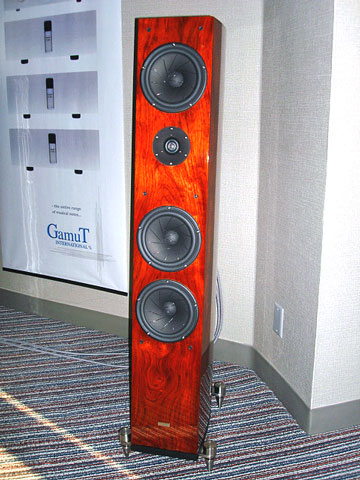David A. Stephens of Rhythm Marketing, GamuT Audio’s U.S. Distributor, and Lars Goller, the owner/designer of GamuT Audio, put on their work suits and greeted visitors at their exhibit.
Being showcased were the top-of-the -line, $14,800/pair L7 loudspeaker, featuring:
* two 7-inch Low Frequency driver made of sliced paper cone, spike-mounted in low compression aerodynamic aluminum chassis;
* one 7-inch Mid Frequency driver of the same specs;
* one 1.5-inch High Frequency ring radiator with stainless steel phase plug, mounted in a non-resonant aluminum chamber of a configuration of low-compression multi-chamber design.
Both Low and Mid Frequency drivers utilized the vented SD-1 motor, while the tweeter is endowed with the SD-2 neodymium motor. It is interesting to note that the smaller, $12k/pair L5 utilizes the same tweeter with two of the Mid Frequency drivers configured to cover the bass/midrange.
In my draft for the L5 review, I noted that, “In producing acoustic instruments, the GamuT L5 exhibits a spectral coherency approaching that of the $26,000 Acapella La Campanella, with unusually discreet upper-bass to midrange uniformity and clarity, producing an Apogee-like liquidity many ribbon speaker aficionados will lust after.”
Pictured above from left to right is the DI150 integrated amplifier, and GamuT’s latest CD player, the CD 3.
At $6,000, the CD 3 weighs over 30 lbs with a rubber-suspended mechanism and digital output board mounted inside a non-magnetic, stainless steel inner chassis. Burr Brown’s 24-bit PCM 1792 takes the 24ibit/192kHz signal from an asynchronous upsampler. Two toroidal transformers feed the digital and analog sections separately.
The $9,800 DI150 weighs 66 lbs and utilizes the same state-of-the-art, single MOSFET technology applied in the D200 MkII power amplifier I reviewed in July 2005 with a slight drop in output power at 180Wpc/8Ω, which is still formidable, because this integrated is implemented in full dual-mono configuration with one 450VA toroidal transformer for each channel. The L7 loudspeaker is of 89dB/4Ω sensitivity and GamuT’s choice of using the DI150 to drive them provided a most revelatory experience for me, as I have been using a DI150 to drive a pair of the L5 and to be able to witness what the DI150 can also achieve with the L7 is ear-opening.
David A. Stephens
AAA Audio (Original, XLH)
Fitted into one of the smaller rooms, the Dynaaudio Confidence C4 as driven by a system of Original CD-A9.3 CD player, XLH SL-11XS preamplifier and XLH M2000 monoblocks produced colossal dynamics, breathtaking dimensionality and spectral coherency.
Most interestingly, piano music as produced, along with all sorts of music that I brought along, didn’t have the room resonance rampant in many other exhibits. This is one exception in which the concept of having a larger of speakers filling up a small room really works and proves to be most conducive.
Original CD-A9.3 CD player, $2,000 Original’s prototype new CD player
Dassun V8i Class- A dual mono integrated amplifier, $1,600
Original XLH M2000 monoblocks, $25,000/pair Dassun V8i, 250Wpc
Kimber Kable (La Reina Room)
Before the Show resumed at 10am on June 3, I joined Ray Kimber for an exclusive demonstration of his IsoMike™-based audio system.
Per Mr. Kimble, IsoMike™ offers music reproduction at its purest form, as facilitated by a carefully coordinated assembly of electronics and technologies. Kimber Kables begins its effort in creating the best recordings from the recording process, in which isolated microphones are separately suspended microphones are contained in a system of experimental acoustic baffles to eliminate inter-channel pickups. Accorded by the painstakingly tuned, heart-shaped baffles that provide an encompassing spectrum in absorption, layers of ultimate details are captured.
I was treated to a wide range of music by Mr. Kimber who operated the command center, including pure chorus, classical and jazz, and contrary to my own experience, the four B&W 800D’s as driven by four Pass Labs X350.2’s produced a spatiality and timbral vividness as I’ve never experienced before. These speakers proved themselves to be most conducive towards recreating the ambiance and musical subtleties even when tasked to filling up such a large ballroom.
The Kimber Kable system contained a DSD hard-disk source of the Genex Audio GX9000, connected to the EMM Labs DAC8 MkIV via a 4-meter run of the Kimber Kable D-60 in BNC, then onward to EMM Labs Switchman III, via two pairs of Kimber Select KS-1130 in a 2-meter run.
A pair of the Kimber Select KS-1130 (3 meters) connected the preamplifier to the Pass Labs X350.5, for the front pair of the B&W 800D Rosenut, which were being fed by Kimber Select KS-3038 (16 feet, 2 pair). Another 6-meter pair of the KS-1130 ran to the 2nd pair of the X350.5, which then connected to the rear channels of the 800D’s via a 30-feet pair of the KS-3038.
Power cables were via the Palladian 14, Palladian 10 and PK 14G.
- (Page 1 of 1)

